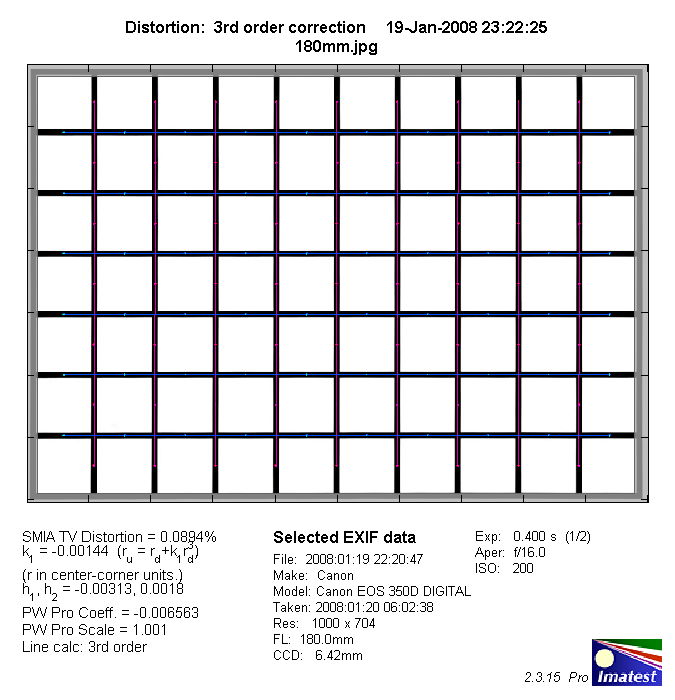|
Canon EF 180mm f/3.5 L USM macro - Review / Test Report - Analysis |
|
Lens Reviews -
Canon EOS (APS-C)
|
|
Page 2 of 2

Distortion
As to be expected from a true macro lens the level of distortion is absolutely negligible.
180mm:

The chart above has a real-world size of about 120x80cm.
Vignetting
When using the lens on an APS-C DSLR there's only a slight degree of vignetting at f/3.5
which shouldn't be problem in most scenes and it's a non-issue at other aperture settings.

MTF (resolution)
In the lab the EF 180mm f/3.5 USM L macro showed a very good performance from
f/3.5 till f/16. Beyond diffraction effects are the limiting factor - the f/32 figures
are not shown below because there's only an image soup left at this setting.
The lens showed a very even performance across the frame without any obvious
centering issues. Nonetheless the MTF figures are a little disappointing for a Canon L grade
tele lens - more so regarding its price tag.
Two lenses have been tested and the results were near-identical. Possibly the performance may
be better at close-focus distances but for mainstream photography this is about what you can expect
from a valid sample of this lens.
Please note that the MTF results are not directly comparable across the different systems!
Below is a simplified summary of the formal findings. The chart shows line widths per picture height (LW/PH) which can be taken as a measure for sharpness.
If you want to know more about the MTF50 figures you may check out the corresponding Imatest Explanations
Chromatic Aberrations (CAs)
Similar to most other fix-focal lenses chromatic aberrations (color shadows at harsh contrast transitions) are
extremely low and nothing to worry about.

Bokeh (out-of-focus blur)
The quality of the bokeh is an important criteria for a tele lens and more so for a macro variant.
This aspect of the EF 180mm f/3.5 USM L has been frequently discussed in many web forums.
At f/3.5 the lens is capable to produce nicely circular and uniform out-of-focus highlights.
However, the situation changes when stopping down to f/5.6 where octagonal shapes start
to appear. This is certainly "too early" for a macro lens which is usually used at
medium aperture settings at macro distances. At f/3.5 the bokeh shows also some one-sides
"smearing" towards the image borders (see the card portion) which doesn't look overly pleasing.
This smearing occurs only in close proximity to the focus point though (see the quadrant).
 Here're two full size samples at f/3.5 and f/5.6.
Here're two full size samples at f/3.5 and f/5.6.
Verdict
The Canon EF 180mm f/3.5 USM L macro is an interesting lens with a very good optical performance
and exceptional mechanical qualities. Nonetheless the lens wasn't really able to fulfill the
high expectations associated with a Canon L grade lens - there're even some zoom lenses performing
better in terms of resolution. Beyond the resolution aspect the lens showed pretty perfect performance
figures - minimal vignetting, next to non-existent distortions and marginal chromatic aberration.
The bokeh, the quality of the out-of-focus blur is relatively decent although not stellar.
The AF performance of the lens is a bit of a mixed bag. If the in-focus point is in a relatively
close proximity to the current setting the AF is fast. However, if the camera has no guidance
where to go the AF is extremely slow. That said AF speed isn't really relevant for pure macro
photography where you tend to use manual focusing anyway. Macro photographers will certainly appreciate
the "true" IF design (constant physical
length) as well as the increased working distance compared to the EF 100mm f/2.8 USM macro.
If macro capabilities aren't on your wish list you may prefer to look elsewhere though.
|
|
Last Updated on Saturday, 12 November 2022 13:44 |